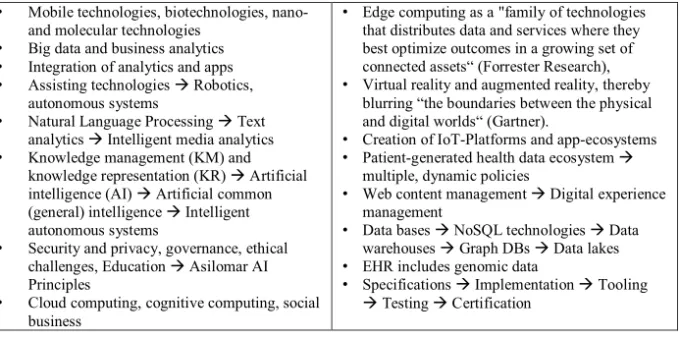Why Interoperability at Data Level Is Not Sufficient for Enabling pHealth?
Volltext
Abbildung
![Table 1. pHealth objectives, characteristics and methodologies/technologies to meet objectives, after [2]](https://thumb-eu.123doks.com/thumbv2/1library_info/3728517.1508385/2.892.113.809.207.1005/table-phealth-objectives-characteristics-methodologies-technologies-meet-objectives.webp)

![Figure 1. Knowledge representation development process (after [25]).](https://thumb-eu.123doks.com/thumbv2/1library_info/3728517.1508385/4.892.154.758.870.1179/figure-knowledge-representation-development-process.webp)
![Figure 2. Conceptual model of architectural descriptions [13], changed after [55])](https://thumb-eu.123doks.com/thumbv2/1library_info/3728517.1508385/9.892.140.741.487.856/figure-conceptual-model-architectural-descriptions-changed.webp)
ÄHNLICHE DOKUMENTE
We have shown that variants of ASH1 that are severely impaired in mitotic chromatin binding cause homeotic trans- formations, deregulate a specific set of genes and are una- ble
function of ImageJ64. C) Magnification of metaphase images from Figures 1 and S1. Despite similar interphase distributions, the ASH1 variants show different extents of
Q15.7 How likely that the major cause for the observed problem is accidental technical failure given that the sensor/sensor communication cable is not easily physically
In case there is no data to be retrieved by external sources, data will be modelled or collected during inventory control.. A possibility to collect data is
Hence, such a framework needs to frame the maritime domain including its stakeholders, the existing and upcoming technical system (architectures), related business processes
These properties notably gave rise to domain-based al- gorithms such as the Co-occurrent Domain Detection (CODD) which allows detection of divergent domains [TGMB09] based on
Second, as a concrete but nevertheless generic implementation of a simulation engine for behavior models, we present se- mantic model specifications and a runtime interfacing to
- Every procedure decision gate has a reference to a decision gate given by the process model and therefore has to be added to a procedure module to include

![Figure 3. Interoperability and Integration Mediated by the ISO Interoperability and Integration Reference Architecture Model [56]](https://thumb-eu.123doks.com/thumbv2/1library_info/3728517.1508385/11.892.99.778.117.466/figure-interoperability-integration-mediated-interoperability-integration-reference-architecture.webp)
![Figure 4. ISO DIS 23903 Mandatory Model and Framework [56].](https://thumb-eu.123doks.com/thumbv2/1library_info/3728517.1508385/12.892.205.682.617.1069/figure-iso-dis-mandatory-model-framework.webp)
![Figure 5. Integration of standards and specifications using the Reference Architecture model [56]](https://thumb-eu.123doks.com/thumbv2/1library_info/3728517.1508385/13.892.92.776.127.623/figure-integration-standards-specifications-using-reference-architecture-model.webp)
![Table 5 compares the different Data Model Levels [46], Modeling Dimensions [48], related Modeling Actors and Model Scopes with ISO 23903 as well as other standards and specifications, demonstrating how ISO 23903 combines and advances all those approache](https://thumb-eu.123doks.com/thumbv2/1library_info/3728517.1508385/14.892.119.806.340.873/different-modeling-dimensions-modeling-standards-specifications-demonstrating-approache.webp)